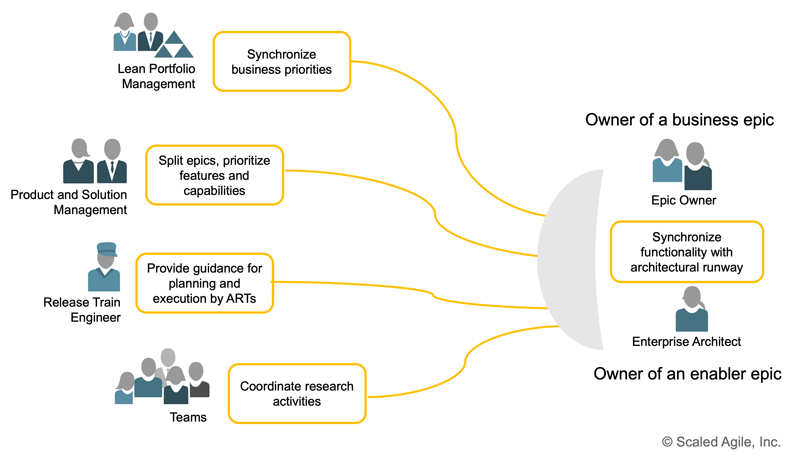To be in hell is to drift; to be in heaven is to steer.
—George Bernard Shaw
Epic Owners
Epic Owners are responsible for coordinating portfolio Epics through the Portfolio Kanban system. They collaboratively define the epic, its Minimum Viable Product (MVP), and Lean business case, and when approved, facilitate implementation.Epic Owner works directly with the Agile Release Train (ART) and Solution Train stakeholders to define the Features and Capabilities that realize the value of approved Epics. They may also have some responsibility for supporting the initiative as it moves downstream through the Continuous Delivery Pipeline to Release on Demand.
Details
In SAFe, epics are the container for significant Solution development initiative. The expectation is that the substantial investment represented by the epic will generate a commensurate amount of economic value. Epic Owners are responsible for formulating and elaborating the epic and analyzing its cost and impact by collaborating closely with other groups in the portfolio.
An Epic Owner can only be effective by collaborating closely with other groups. They help fill in the gaps that often occur when high-level initiatives descend from the top of the organization for implementation. Key collaborators are highlighted in Figure 1.

By working closely with these key stakeholders, Epic Owners can create a realistic and compelling vision, appropriate economic priorities, and a consistent set of features and capabilities.
Summary Role Description
The Epic Owner is responsible for guiding individual epics through the Portfolio Kanban system from identification through LPM approval. After the epic is approved, the Epic Owner works with Agile Teams to initiate the development activities necessary to realize the epic’s business outcome hypothesis. After the initiation, the Epic Owner may have some ongoing responsibilities for stewardship and follow-up. As the features and capabilities that define the epics are incorporated into the Solution, the Epic Owner returns to other duties or takes responsibility for other emerging epics. After development is safely underway, the ARTs have the responsibility for implementing the new epic into the solution. Typically, an Epic Owner works with the one or two epics at a time that falls within their area of expertise and current business mission.
Responsibilities
The Epic Owner in SAFe is a role assumed by an individual; it is not a job title. The Epic Owner assumes the duties outlined in the paragraphs below.
Preparing the Epic
The Epic Owner’s responsibilities begin early in the epic’s life cycle. They include:
- Working with stakeholders and subject matter experts to define an epic using the ‘epic hypothesis statement’
- Working with internal teams and external Suppliers to develop cost estimates used in Participatory Budgeting
- Working with internal teams to size the epic and provide input for economic prioritization based on Weighted Shortest Job First (WSJF), the Lean business case, and other relevant factors
- Shepherding epics through the portfolio Kanban system and creating the Lean business case [1]
- Preparing to present the Lean business case to LPM for a go/no-go decision
Presenting the Epic
The Epic Owner has the primary responsibility for introducing the merits of the epic to LPM. Approval, however, is not automatically granted, as enterprises typically have ideas and opportunities that far exceed capacity. Accordingly, when presenting the epic, the Epic Owner should focus on the merits of the business case of a specific epic, secure in the knowledge that the collaborative discussions that form the foundation of LPM will ensure that the portfolio is making optimal investment choices.
Implementation
If the epic is approved, Epic owners:
- Collaborate with Product and Solution Management and System and Solution Architects/Engineering to decompose the epic into features and capabilities and help prioritize these backlog items in their respective program and solution backlogs
- Participate in Program Increment (PI) Planning, System Demo, and Solution Demo, whenever there is critical activity related to the epic
- Work with Agile Teams that perform research spikes, create proofs of concept, mock-ups, etc
- Coordinate and synchronize epic-related activities with sales, marketing, and other business units
- Understand and report on the progress of the epic’s MVP with key stakeholders and LPM
- Facilitate, as needed, the implementation of the epic through the continuous delivery pipeline and release on demand
The role of the Epic Owner is considered complete when the epic is no longer a LPM concern and the ART has sufficiently integrated the epic into their work that the Epic Owner’s role is no longer providing value.
Learn More
[1] Leffingwell, Dean. Agile Software Requirements: Lean Requirements Practices for Teams, Programs, and the Enterprise. Addison-Wesley, 2011.Last update: 10 February 2021





